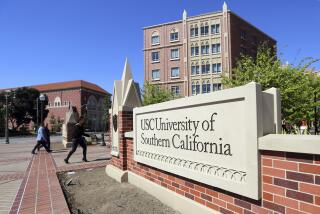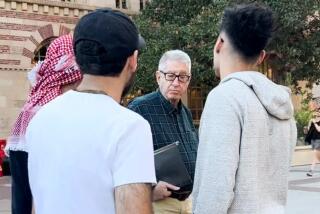Nathan Friedman dies at 97; pioneering USC professor of dentistry
Dr. Nathan Friedman, a pioneering periodontist and USC professor of dentistry who developed a groundbreaking curriculum in the 1960s aimed at helping apprehensive patients overcome their fear of dental work, has died. He was 97.
Friedman died May 27 in Los Angeles of complications related to old age, said his daughter, Susan Friedman.
His focus on improving what he called the dentist’s “chair-side manner” grew out of observations he made in his Beverly Hills practice and an increasing fascination with psychology.
“When two or three patients in a row greet you with, ‘What kind of torture do you have in mind for me today?’ it can start to get to you,” Friedman told The Times in 1975.
Within the USC School of Dentistry, he founded the department of behavioral dentistry in 1964 and served as its chairman for decades. At the time, the department was a novelty in U.S. dental education, Friedman wrote in 1988 in The Times.
Using psychological principles, students were taught to question patients about their fears, discuss the roots and try to help them overcome them.
Wayne Waller, a former USC assistant professor of human behavior who worked closely with Friedman, said the dentist was “way ahead of his time.”
“It was an indignity to him that anyone should fear him or others in his profession,” Waller said. “He spent much of his career developing a methodology to help people in concrete ways. It became a model for many programs in this country and around the world to treat fear in dentistry.”
Friedman named his fear-reduction technique iatrosedation -- “iatros” for the Greek word for doctor and “sedation” for the ability to calm.
To graphically convey the concept, the dentist who counted celebrities -- including Walter Matthau, Danny Kaye and Lucille Ball -- among his patients took his fear-not message slightly Hollywood.
He co-wrote a script for a film that USC’s cinema school made under the supervision of Sol Lesser, known for producing “Tarzan” movies. Matthau volunteered to narrate the film that shows a caregiver dealing with a patient’s anxiety.
After the movie, “Treating Fear in the Dental Patient,” was screened in 1972 at an American Dental Assn. meeting, “it evoked an enthusiastic response” and was later shown at major dental gatherings around the world, Friedman recalled in The Times in 1988.
As a periodontist, Friedman also did influential work in the specialty that deals with diseases of the gum and other structures around the teeth. One of his major contributions was coming up with precise terminology for periodontic techniques, said Dr. Hessam Nowzari, director of USC’s periodontology program.
Some of Friedman’s research of periodontal treatment and bone surgery “was so solid it will never age,” Nowzari said. “Even today I still teach his findings.”
Friedman was born May 18, 1912, in New Jersey to Meyer Friedman, who worked in clothing manufacturing, and his wife, Sarah.
The family moved to New York City when Nathan was about 10.
He earned a degree from Northwestern University’s dental school in 1936 and served as an Army dentist in the U.S. during World War II.
In the late 1940s, Friedman was one of the first dentists to enroll in Columbia University’s periodontal program. After graduating in 1951, he came west in search of better weather, started teaching at USC and opened his practice.
Actor Robert Wagner, who was a patient for 30 years, called Friedman “a very special human being” and close friend.
“When I would go to see him, his staff would schedule a double appointment because we would talk for 45 minutes before he put a mirror in my mouth,” Wagner said.
Friedman would make sure the right music was playing before the Mozart-loving Matthau arrived for his appointment, but he also had a sliding-fee scale for people who couldn’t afford his usual rates, according to Janet Breyer, Friedman’s stepdaughter.
He practiced dentistry until he was 88.
“What was most inspiring about him,” said Waller, “was his belief that people can help others live good, happy lives by just taking a moment. He believed you really had to model what you wanted from the world.”
Friedman, who lived in Beverly Hills, is survived by his wife, Muriel, whom he married in 1961; daughter Susan of Sherman Oaks; and stepdaughter Janet of Bend, Ore.
Memorial donations may be made to the USC School of Dentistry, https://dentistry.usc.edu.
More to Read
Start your day right
Sign up for Essential California for the L.A. Times biggest news, features and recommendations in your inbox six days a week.
You may occasionally receive promotional content from the Los Angeles Times.







